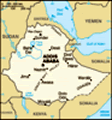Advertisement
Published: July 18th 2019
Our third tribe visit took on quite a different approach - it was predominantly a photo stop. The Karo tribe live in a very isolated settlement overlooking the east bank of the impressive Omo River, with the 2 hour drive from our lodge at Turmi through pretty rough terrain and not passing through a single village or settlement. The main crops grown by them are sorghum, maize and beans. But their main claim to fame is their heavily painted bodies and faces, which was quite a change from the previous two tribes we visited, who had basically become westernised in their respective wardrobes. They prepare for ceremonies by painting themselves with chalk, which is mixed with yellow rock, red iron ore and charcoal to make its various colours. Face masks are worn occasionally as are clay hair buns with feathers in them. Many of the older men wear considerable marking all over their chest and face to represent dangerous animals killed.
Photography by tourists of course comes at a price as this contributes heavily towards their community costs. Fortunately we came to an arrangement with our guide to pay a blanket price for all photos, paid to the village chief
which then goes into community coffers, rather than payment to individuals, which also had the potential to result in jealousy and conflict. As a result of this free reign, we were besieged with requests to “Photo me, mister”, immediately followed in many instances, especially by the young ones, by a request to be shown the photo of themselves (however did they cope before digital cameras?). I think we ended up with almost a hundred photos each from the visit, which will clearly need to be edited back a bit. Of particular interest to me was the group of a dozen or so young ‘apprentices’ who were sitting in a group practicing their art. I almost had a new addition to our family. On our arrival, a young boy grabbed my hand and was reluctant to let go of me the whole visit. I don’t know if he is lacking in love from his own family but an Ethiopian adoption is just not on our plans right now!
After lunch, we had our first taste of a local market, this one run in Turmi by the local Hamar tribe. The wares offered were extensive but pretty basic, as you would
expect for a fairly simplistic group of people. We sensed that this was as much a social occasion for the predominantly Hamar women, who seemed more interested in sitting around chatting than seeking buyers for their goods. We took a number of photos but by necessity they were long shots to avoid invading anyone’s privacy, so it will be interesting to see how these blow up when I get home.
Our final visit for the day, and our fourth tribe visit, was to the actual Hamar village, only a few kilometres out of Turmi. Although we left it until late in the day, we were obviously too early for most of the Hamar adults, who were still returning from the markets, but we were besieged instead by the young children left behind. It was a strange and somewhat uncomfortable visit for us. First our local Hamar guide introduced us to one of the chiefs, who allowed us to take his photo but then got into an extremely animated conversation with our guide (subject unknown!). They were then joined by a third male who joined the fray and was even more animated, pointing fingers and arguing for around 15 minutes
while Bruce and I stood by looking like dummies.
The village was pretty much deserted of females, all still returning from the markets, which was disappointing, seeing that they are the main attraction with their unique basin-cut hairstyles made from a combination of ochre, butter and incense, along with a unique circular wedge necklace if they are married. However, our guide finally extracted a married lady from one of the huts who graciously allowed us to photograph her before wheeling out her two grandmothers (not a photographer’s delight I’m afraid!) and then she too got into a heated discussion with our guide and another male which lasted a further 15 minutes (subject also unknown, although we gathered it was about a recent poor experience with some Chinese tourists). Having had a look around and taken a few pics, Bruce and I decided it was time to beat it, but on our way out our guide was accosted yet again by the chief for another 10 minute debate. I guess we’ll never know the topic and maybe in their culture this is a normal style of discussion, but it left us feeling quite uncomfortable and like shags on a rock.
So tomorrow we are off to visit another tribe called the Dassanechs, based on the other side of the Omo River, before making our way up to our final overnight spot of Jinka.
Advertisement
Tot: 0.108s; Tpl: 0.017s; cc: 15; qc: 27; dbt: 0.0708s; 1; m:domysql w:travelblog (10.17.0.13); sld: 1;
; mem: 1.2mb



























Dancing Dave
David Hooper
Ethiopia: The Karo...Handsome is an Art Form
We found the Karo the friendliest of the Omo Valley tribes. Seems with this little fella you know what I mean. Check out my blog of the above name of our bond with the Karo that made our day.